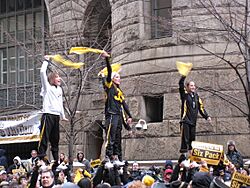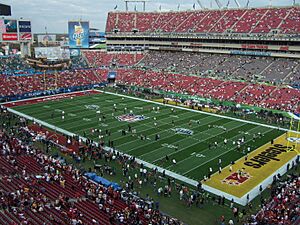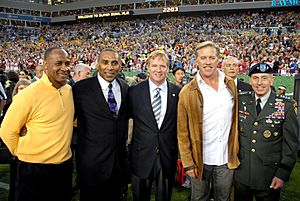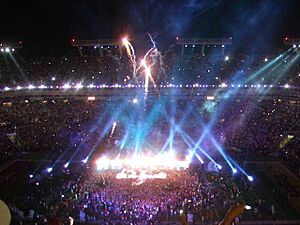Super Bowl XLIII facts for kids
 |
|||||||||||||||||||
|
|||||||||||||||||||
|
|||||||||||||||||||
| Date | February 1, 2009 | ||||||||||||||||||
|---|---|---|---|---|---|---|---|---|---|---|---|---|---|---|---|---|---|---|---|
| Stadium | Raymond James Stadium, Tampa, Florida | ||||||||||||||||||
| MVP | Santonio Holmes, wide receiver | ||||||||||||||||||
| Favorite | Steelers by 7 | ||||||||||||||||||
| Referee | Terry McAulay | ||||||||||||||||||
| Attendance | 70,774 | ||||||||||||||||||
| Hall of Famers | |||||||||||||||||||
| Steelers: Dan Rooney (owner/administrator), Bill Nunn (scouting assistant), Troy Polamalu Cardinals: Edgerrin James, Kurt Warner |
|||||||||||||||||||
| Ceremonies | |||||||||||||||||||
| National anthem | Jennifer Hudson | ||||||||||||||||||
| Coin toss | Gen. David Petraeus | ||||||||||||||||||
| Halftime show | Bruce Springsteen and the E Street Band | ||||||||||||||||||
| TV in the United States | |||||||||||||||||||
| Network | NBC | ||||||||||||||||||
| Announcers | Al Michaels, John Madden, Andrea Kremer and Alex Flanagan | ||||||||||||||||||
| Nielsen ratings | 42.0 (national) 53.6 (Pittsburgh) 47.5 (Phoenix) US viewership: 98.7 million est. avg., 151.6 million est. total |
||||||||||||||||||
| Market share | 65 (national) 79 (Pittsburgh) 80 (Arizona) |
||||||||||||||||||
| Cost of 30-second commercial | $3 million | ||||||||||||||||||
| Radio in the United States | |||||||||||||||||||
| Network | Westwood One | ||||||||||||||||||
| Announcers | Marv Albert, Boomer Esiason, John Dockery and Mark Malone | ||||||||||||||||||
Super Bowl XLIII was an exciting American football game. It was played on February 1, 2009, in Tampa, Florida. This game decided the champion of the 2008 NFL season. The Pittsburgh Steelers from the American Football Conference (AFC) played against the Arizona Cardinals from the National Football Conference (NFC).
The Steelers won the game 27–23. This victory made them the first team to win six Super Bowl championships. It was also their second Super Bowl win in just four years. The Cardinals were hoping to win their first NFL title since 1947. They had the longest championship wait in the league. The Cardinals surprised many by having a good season. They finished with a 9–7 record and made it to the playoffs. Their coach, Ken Whisenhunt, used to be a Steelers coach. Their quarterback, Kurt Warner, was a Super Bowl MVP before.
Pittsburgh started strong, leading 17–7 at halftime. A huge play helped them: linebacker James Harrison ran back an interception 100 yards for a touchdown. This was a Super Bowl record! In the fourth quarter, the Cardinals made an amazing comeback. They scored 16 points in a row. This included a safety and a 64-yard touchdown catch by Larry Fitzgerald. They took the lead 23–20 with only 2:37 left.
But the Steelers fought back. They moved 78 yards down the field. Wide receiver Santonio Holmes caught a 6-yard touchdown pass. This game-winning play happened with only 35 seconds left! Holmes was named Super Bowl MVP. He caught nine passes for 131 yards. He also had four catches for 73 yards on that final drive. He was the sixth wide receiver to win this award.
The NBC broadcast of the game was very popular. About 98.7 million people in the U.S. watched it. At the time, it was the most-watched Super Bowl ever. Many people still think this was one of the best Super Bowls. It was exciting because both teams played well. The ending was also thrilling. The NFL Network ranked it as one of the "Top 10 Greatest Games of All Time." It was also ranked No. 1 for "Top 10 Super Bowls." This was the Steelers' last Super Bowl championship until 2022. It was also the last game for famous commentator John Madden, who retired soon after.
Contents
Game Location: Where Was it Played?
The Super Bowl XLIII game was held in Tampa, Florida. Tampa was chosen on May 25, 2005. It beat out other cities like Atlanta and Miami. This was the second Super Bowl held at Raymond James Stadium. It was the fourth Super Bowl overall in Tampa.
The Super Bowl XLIII logo was revealed in 2008. It showed a football stadium with blue and green colors. These colors represented the water and nature of Tampa Bay. The logo also had two stars. One red star for the AFC and one blue star for the NFC. The game's motto was "Believe In Now."
Meet the Teams: Steelers and Cardinals
This Super Bowl featured two teams with interesting histories. The Pittsburgh Steelers had won the Super Bowl in 2005. But they had a tough year in 2006. Their long-time coach, Bill Cowher, left the team. The Steelers then hired Mike Tomlin as their new coach.
The Arizona Cardinals had a very different story. They had not won an NFL championship since 1947. They had never even been to a Super Bowl before! Their new coach was Ken Whisenhunt. He used to be a coach for the Steelers. He joined the Cardinals with Russ Grimm, another former Steelers coach. Together, they helped turn the Cardinals into a winning team.
This game was special because it matched two very old NFL teams. The Cardinals were founded in 1898. The Steelers started in 1933. It was also rare to see two quarterbacks who had already won Super Bowls play against each other. Kurt Warner had won a Super Bowl with the St. Louis Rams. Ben Roethlisberger had won one with the Steelers.
Pittsburgh Steelers: The Road to the Super Bowl

Under Coach Tomlin, the Steelers improved a lot. In 2008, they had a 12–4 record. This was the second-best record in the AFC. They made it to the playoffs for the sixth time in eight seasons. This was their seventh trip to the Super Bowl.
The Steelers were known for their amazing defense. They allowed the fewest points and yards in the NFL. Linebackers LaMarr Woodley and James Harrison were great at sacking the quarterback. Harrison was even named the NFL Defensive Player of the Year. Safety Troy Polamalu was also a star. He had seven interceptions.
On offense, quarterback Ben Roethlisberger led the team. He threw for over 3,300 yards. His main target was Hines Ward, who had over 1,000 receiving yards. Other key receivers were Santonio Holmes and Nate Washington. Running back Willie Parker led the ground game. Even with some injuries, the Steelers were a strong team. They entered the playoffs as the second seed in the AFC.
Arizona Cardinals: The Unexpected Journey
The Arizona Cardinals had a long history of not winning championships. They had only won one playoff game since 1947. But in 2008, things changed. They started the season winning 7 of their first 10 games. Even though they struggled a bit at the end, they finished 9–7. This was enough to get them into the playoffs. They became only the second NFL team to reach the Super Bowl with just nine wins.
A big reason for their success was quarterback Kurt Warner. He was 37 years old and had a comeback story. Warner had won two MVP awards and a Super Bowl with the St. Louis Rams. After some tough years with injuries, he joined the Cardinals. In 2008, he had one of his best seasons. He threw for 4,583 yards and 30 touchdowns.
Warner had three amazing receivers: Larry Fitzgerald, Anquan Boldin, and Steve Breaston. Each of them had over 1,000 receiving yards. This was a rare achievement for any team. Running backs Edgerrin James and Tim Hightower helped with the running game. The Cardinals' offense was one of the best in the league.
Their defense had been inconsistent during the regular season. But they played much better in the playoffs. They forced many turnovers. This helped them win three playoff games. They beat the Atlanta Falcons, Carolina Panthers, and Philadelphia Eagles. They won more playoff games this season than in their entire history before!
Playoff Path to the Super Bowl
Both teams had to win tough playoff games to reach the Super Bowl.
- The Steelers first beat the San Diego Chargers 35–24. They controlled the game and scored in every quarter.
- Then, they defeated their rivals, the Baltimore Ravens, 23–14 in the AFC Championship Game. They forced five turnovers in that game.
- The Cardinals started by beating the Atlanta Falcons 30–24.
- Next, they upset the Carolina Panthers 33–13.
- Finally, they won the NFC Championship Game against the Philadelphia Eagles 32–25.
Kurt Warner played incredibly well in the playoffs. He threw for 661 yards and eight touchdowns. Larry Fitzgerald also set a playoff record with 419 receiving yards and five touchdowns.
Broadcasting the Big Game
Watching in the United States
The game was shown live on NBC in the United States. This was NBC's first Super Bowl broadcast since 1997. The main announcers were Al Michaels and John Madden. John Madden became the first person to announce a Super Bowl for all four major U.S. TV networks. This was also the last game Madden ever called before he retired.
The pregame show was five hours long! It featured the Football Night in America team. There was also a special Today show. It included an interview with President Barack Obama. The game was shown in high definition. It was also the last Super Bowl to be shown on regular analog TV in the U.S.
TV Ratings and Commercials
About 98.7 million people watched Super Bowl XLIII. This made it one of the most-watched Super Bowls ever at that time. The game was especially popular in Pittsburgh and Phoenix.
A 30-second commercial during this Super Bowl cost about $3 million. This was a new record! Many big companies like Anheuser-Busch (Budweiser) and PepsiCo bought several ads. However, the "Big Three" U.S. car makers (General Motors, Ford, and Chrysler) did not run ads. This showed how tough the economy was in 2009.
Some popular ads included:
- A fan-made Doritos ad about a "crystal ball."
- Budweiser ads featuring dancing Clydesdale horses.
- A Bridgestone ad with Mr. and Mrs. Potato Head.
Watching Around the World
The Super Bowl was broadcast in many countries. It was shown in places like Australia, Brazil, Canada, China, Germany, Japan, Mexico, and the United Kingdom. An international broadcast with different announcers was seen in 230 countries. It was available in 61 networks and 34 languages!
Listening on the Radio
Westwood One had the national radio rights for the game. Marv Albert and Boomer Esiason were the announcers. Local radio stations for the Steelers and Cardinals also broadcast the game. There was even a Spanish-language broadcast for listeners in the U.S.
Halftime Show and Pregame Fun
Before the Game Starts

Before the game, Journey and the Bethune-Cookman University Marching Wildcats performed. Jennifer Hudson sang "The Star-Spangled Banner." This was her first public performance after a family tragedy. The United States Air Force Thunderbirds also did a fly-over. Faith Hill sang "America the Beautiful." The crew of US Airways Flight 1549, who landed a plane safely on a river, were honored.
The coin toss featured NFL legends like Roger Craig, John Elway, and Lynn Swann. General David Petraeus flipped the coin. The Steelers called tails, but it landed on heads. The Cardinals won the toss and chose to kick off. This was the first time in Super Bowl history that the coin toss winner chose to kick off first.
Halftime Show: Bruce Springsteen Takes the Stage
The Super Bowl XLIII halftime show featured Bruce Springsteen and the E Street Band. They played some of their famous songs:
- "Tenth Avenue Freeze-Out"
- "Born to Run"
- "Working on a Dream"
- "Glory Days"
Bruce Springsteen had turned down playing at the Super Bowl many times before. But he finally agreed for this game.
Game Highlights: A Play-by-Play Look
This Super Bowl was full of exciting moments and big plays!
First Quarter Action
The Steelers started strong. They drove down the field 71 yards. Quarterback Ben Roethlisberger threw a long pass to Hines Ward. They got to the Cardinals' 1-yard line. Roethlisberger tried to score, but a replay showed his knee touched the ground. So, the Steelers kicked an 18-yard field goal. They led 3–0.
Pittsburgh quickly got the ball back. Roethlisberger threw a 25-yard pass to Santonio Holmes. They kept moving the ball down the field.
Second Quarter Excitement
Early in the second quarter, Gary Russell scored a 1-yard touchdown run for the Steelers. This made the score 10–0. The Steelers were playing great defense, too.
The Cardinals fought back. Quarterback Kurt Warner led an 83-yard drive. He completed many passes, including a 45-yard pass to Anquan Boldin. Warner then threw a 1-yard touchdown pass to Ben Patrick. The score was now 10–7.
Later in the quarter, the Cardinals got a chance to take the lead. But with only 18 seconds left, Warner's pass was intercepted. Linebacker James Harrison caught the ball at the goal line. He then ran 100 yards for a touchdown! This was the longest play in Super Bowl history at the time. It gave the Steelers a 17–7 lead at halftime.
Third Quarter: Steelers Extend Their Lead
After halftime, the Steelers kept up their momentum. They had a long drive that lasted over eight minutes. They moved 79 yards down the field. Even though they couldn't score a touchdown, they kicked another field goal. Jeff Reed made a 21-yard field goal. The Steelers' lead grew to 20–7.
Fourth Quarter Thrills and the Final Play
The fourth quarter was incredibly dramatic!
- Warner led the Cardinals on an 87-yard drive. He threw short passes, and Larry Fitzgerald caught many of them. Fitzgerald then made a leaping 1-yard touchdown catch. The score was 20–14.
- Later, the Cardinals pinned the Steelers deep in their own territory. Steelers center Justin Hartwig committed a holding penalty in the end zone. This resulted in a safety for the Cardinals! The score became 20–16.
- After the safety, the Cardinals got the ball back. Warner threw a pass to Fitzgerald, who ran for a 64-yard touchdown! This gave the Cardinals their first lead of the game, 23–20, with only 2:37 left.
The Steelers had one last chance. They started at their own 22-yard line. Roethlisberger threw several passes to Santonio Holmes. Holmes made a huge 40-yard catch that got them close to the goal line. Two plays later, Roethlisberger threw to Holmes in the corner of the end zone. Holmes made an amazing 6-yard touchdown catch, keeping both feet in bounds! After a review, the touchdown stood. The Steelers led 27–23 with only 35 seconds left.
The Cardinals tried one more play. Warner threw a pass, but linebacker LaMarr Woodley sacked him and forced a fumble. The Steelers recovered the ball! Roethlisberger then kneeled down to end the game. The Pittsburgh Steelers won their sixth Super Bowl!
Game Statistics: Who Did What?
The game had some interesting statistics. The Cardinals had more passing yards (374 to 234) and total yards (407 to 292). But they had more penalties.
- Kurt Warner threw for 377 yards and three touchdowns. This was the second-most passing yards in Super Bowl history at the time.
- Larry Fitzgerald caught seven passes for 127 yards and two touchdowns. He set a playoff record with seven touchdown catches in a single postseason.
- Ben Roethlisberger threw for 256 yards and one touchdown.
- James Harrison's 100-yard interception return is still the longest in Super Bowl history.
- The Steelers became the first team to win three Super Bowls in the same state (Florida).
Images for kids
-
Three Steelers fans waving Terrible Towels at a Pittsburgh rally prior to the game.
-
Fans wave as the United States Air Force Thunderbirds fly over the stadium during the pregame ceremony
-
Lynn Swann, Roger Craig, NFL Commissioner Roger Goodell, John Elway, and Gen. David Petraeus











